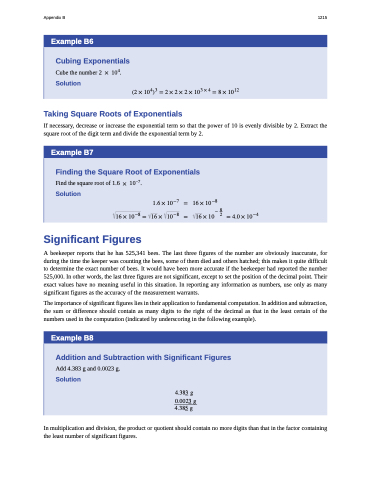Page 1225 - Chemistry--atom first
P. 1225
Appendix B 1215
Example B6
Cubing Exponentials
Cube the number 2 � 104. Solution
�������� ������������ �������
Taking Square Roots of Exponentials
If necessary, decrease or increase the exponential term so that the power of 10 is evenly divisible by 2. Extract the square root of the digit term and divide the exponential term by 2.
Example B7
Finding the Square Root of Exponentials
Find the square root of 1.6 � 10−7. Solution
�������� � �������
�������� ��� ���� � �������� ���������
Significant Figures
A beekeeper reports that he has 525,341 bees. The last three figures of the number are obviously inaccurate, for during the time the keeper was counting the bees, some of them died and others hatched; this makes it quite difficult to determine the exact number of bees. It would have been more accurate if the beekeeper had reported the number 525,000. In other words, the last three figures are not significant, except to set the position of the decimal point. Their exact values have no meaning useful in this situation. In reporting any information as numbers, use only as many significant figures as the accuracy of the measurement warrants.
The importance of significant figures lies in their application to fundamental computation. In addition and subtraction, the sum or difference should contain as many digits to the right of the decimal as that in the least certain of the numbers used in the computation (indicated by underscoring in the following example).
Example B8
Addition and Subtraction with Significant Figures
Add 4.383 g and 0.0023 g.
Solution
������ �
������� � ������ �
In multiplication and division, the product or quotient should contain no more digits than that in the factor containing the least number of significant figures.


